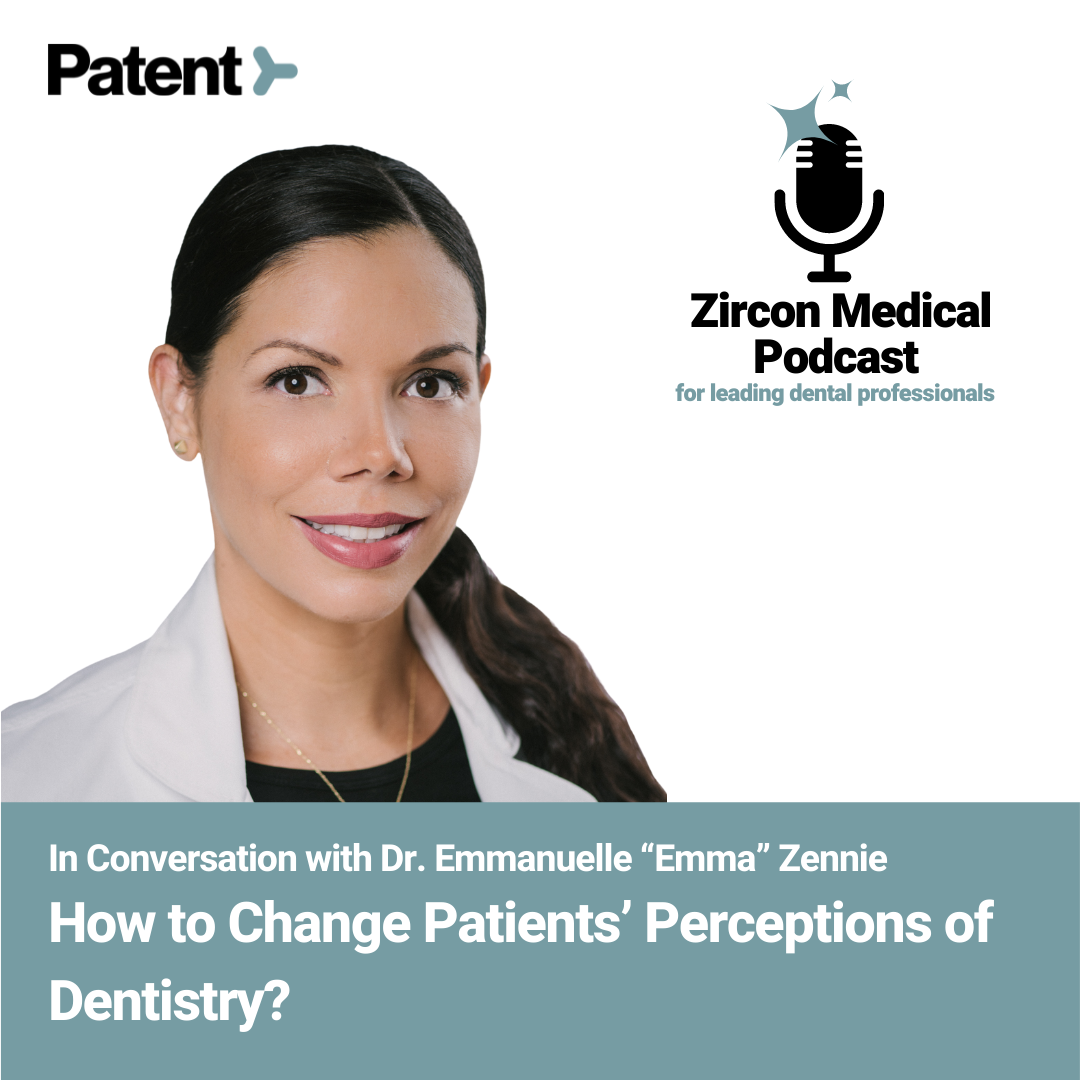Dr. Emmanuelle Zennie
Owner of Dental Practice in Haiti
Licensed as a dental professional in USA and Haiti
Bachelor of Science in Microbiology
Master’s in Biomedical Science
Doctorate in Medical Dentistry
Website: http://www.winwellhaiti.com/
Instagram: @dr.emmanuellezennie
130, Rue Louverture,Pétion ville, Haiti
In Conversation with Dr. Emmanuelle “Emma” Zennie
Dentists must often navigate considerable resistance from their patients, especially since so many dental treatments are preemptive or preventative. Furthermore, patients can’t always see the results of their often painful and expensive treatments, leading to the assumption that they’re being upsold on treatments they don’t need. This creates a massive hurdle for dentists who must impress upon their patients the need for treatment. In order to overcome such hurdles, dentists must change their patients’ perceptions of dentistry.
Our team at Zircon Medical hosted Dr. Emmanuelle “Emma” Zennie on our podcast series to discuss how to change patients’ perceptions of dentistry for their benefit.
Introducing Emma, the owner of a dental practice in Haiti
Dr. Emmanuelle Zennie is licensed as a dental professional in the state of Florida, USA, and Haiti. She insists we simply call her Emma because she doesn’t believe in titles, hierarchies, white coats, or anything that creates a distance from patients. Instead, she likes to converse with her patients directly and sees herself as a humble service provider.
Emma completed her entire college education in the United States, including a Bachelor of Science in Microbiology, Master’s in Biomedical Science, and a Doctorate in Medical Dentistry. After working exclusively in Haiti for a few years, Dr. Zennie accepted an offer to cooperate with her mentor in South Florida. She now splits her time between Miami and Haiti.
Dr. Zennie says she always wanted to be a dentist, even though there are no other dentists in her family. She attributes it to an incident from when she was only 12 years old. Her wisdom tooth had erupted at an extremely early age, but it was growing out inverted, so it had to be removed. Her dentist performed a germectomy to remove the wisdom tooth.
“While he worked, I was listening to my New Kids on the Block CD,” Emma recounts. “I was looking at what he was doing in my mouth, and it was the most fascinating thing. And that’s when I knew I wanted to be a dentist.” Dr. Zennie adds that she followed a career based on her childhood aspirations and dreams, and she’s clearly thrilled about having done so.
The importance of changing patients’ perceptions of dentistry
Dr. Zennie says general practitioners are responsible for receiving patients, educating them, explaining what they need and their available options, and convincing them to undergo treatments. “I can’t think of any other profession in the world where people sit down, look at you, and say I hate you,” Emma adds emphatically. “They don’t know your name, don’t know who you are, but they hate you, or rather, they hate what you do.”
Emma states that dental care is terribly received by patients. And she attributes that negative perception to the fact that most people aren’t equipped to make decisions in their best interests. Because practitioners like Emma have to sit them down and tell them what they need, thus turning them into subjects rather than active participants in the interaction. When most patients express their dissatisfaction with dental care, it’s an expression of discontent at the loss of agency.
“People may forget what you say and what you do,” Dr. Zennie adds. “But they remember how they felt in the chair. If you can create a sense, even if the treatment is difficult or expensive, that the patient is participating and actively making a decision for themselves, you’ll get patients who are compliant and want to proceed with the treatment.” As such, Dr. Zennie frames the act of changing patients’ perceptions as turning them into active participants in charge of their own fates.
The differences in patient perception between the USA and Haiti
In Haiti, Emma says most people don’t perceive dental care as something to seek regularly. Most patients only visit dentists when their teeth hurt or when they can notice problems themselves. And since they primarily associated dental appointments with toothaches, they have an inbuilt negative association with dentistry. “Apparently, dental pain hurts a lot,” Emma adds good-humoredly, “or at least that’s what I’ve been told.”
In the United States, Dr. Zennie says most patients visit dentists because they have dental insurance or there’s an active special for patients to come in and get cleanings. They’re more under the constraints of what they perceive as necessary, as dictated by their insurance. “What ties these together,” Dr. Zennie says, “is that patients don’t trust you because you’re there to sell something that hurts, is expensive, and something no one sees.”
“If you go to a plastic surgeon for a breast implant,” Emma continues, illustrating her point, “your treatment may hurt and be expensive, but at least people will see the work. In most cases, when you fix teeth, the work can’t be seen. Even with tooth replacement, patients often think the back teeth don’t need to be replaced because no one will see them. They don’t understand that the front teeth rely on the back teeth.”
Dr. Zennie says most patients only want to whiten their front teeth or place veneers since these treatments produce visible results. If patients don’t replace back teeth, their front teeth will flare out, and they’ll eventually lose all their teeth. “Patients need this education — you explain how the oral system works, how the teeth work, and how all of them have value, not just the front teeth.”
How to change patients’ perceptions of dentistry
Make your patients feel comfortable with you
Dr. Zennie says the first part of changing patients’ perceptions of dentistry is making them feel comfortable. She says she never stands up and talks down to her patients because it can make them feel uncomfortable. Instead, she sits down and adjusts her chair to ensure she’s at eye level with them. This position and posture make her patients feel comfortable, making them more receptive to what she says.
Listen to their concerns before making personal assessments
Emma says her first question always starts with, “how can I help you today?” She says it’s crucial to listen to patients and their concerns, treating them as clients rather than proceeding with a case analysis without considering their needs. “Your number one job is to identify the purpose of the visit, understand the cause or root of the problem, and then inform them that you need to take x-rays.”
Break the entire treatment into manageable chunks
Dr. Zennie says she mostly treats patients between 50 and 70 years of age, and they usually need a lot of work, which can be quite shocking. She breaks the treatment down, starting with a disease control plan for immediate needs, which may include cleanings, deep cleanings, repairing teeth that can be saved and extracting those that can’t.
She proceeds with rehabilitation once the patient is out of medical harm, i.e., they can no longer get sick from their teeth. She says it’s a matter of sequencing the ideas after identifying the problems to make them seem more manageable.
Make patients understand your perspective
Emma says patients often suspect that dentists are upselling them on treatments they don’t need. They assume that dentists look for things to do in their mouths to make more money. She changes that perception by openly informing the patients of her perspective.
“You need them to understand that you’re looking at an x-ray and are responsible for all the information you see,” she says. “If I don’t tell you about the other things you need based on what I’m seeing on this x-ray, then I’m not doing my job, and I can be held liable for neglect.”
Encourage patients to ask questions
Dr. Zennie says patients often avoid asking questions because they’re apprehensive or scared. However, she believes it’s the dentist's responsibility to ensure the patient feels comfortable asking questions. That’s why she actively solicits questions from her patients, which can help them understand the need for their treatment and provide informed consent.
"If a patient doesn’t understand the proper justification for treatment,” Dr. Zennie says, "They can’t give you proper consent. And if patients understand why they need the treatment, you can sell to the patient the treatment they need.”
" That's ethics, empowering someone to want the treatment because they understand that they need it.”
Make them responsible for their health
Emma says she informs her patients, right at the beginning, that she can’t control how they heal. She usually performs revision surgeries at cost, once, if they don’t heal properly. However, she informs them that they must follow her postoperative instructions clearly for the strongest chance of healing properly. They take treatments more seriously when they’re made responsible for their own health and treatment.
Communicating effectively with patients
Dr. Zennie says she was in school with a lot of dentists, and she met many other dental professionals during conferences. In all of her interactions, she says she’s realized that dentists are great at communicating with each other, but they lack communication skills in general. And communication skills aren’t taught in school, so they must be imbibed naturally.
“If you’re a good communicator, you’ll be a successful dentist,” Emma adds succinctly. “But if you’re not, you have to wait for other people to refer you for procedures because you won’t convince anyone for treatment yourself.”
Educating patients about oral health and changing dental treatments
Dr. Zennie places extremely high importance on educating her patients on an ongoing basis. That falls in line with her belief that uninformed patients can’t offer informed consent for treatments, so ethics demand that patients are always kept educated. She says she’s had patients who have had double triple bypass surgeries for their heart, and they don’t realize that their periodontal disease significantly contributes to the risk of cardiovascular problems.
Emma also says it’s hard to transmit to patients the idea that science is constantly evolving. She says she’s currently in the process of shifting to biologic dentistry and eliminating all metals from her practice. And it’s hard to tell patients that there are new options available, that there’s a new kind of implant (ceramic) available. Biologic dentistry is a better option for patients worried about metal oxidation, but it’s hard to communicate the shift.
“Communication and education aren’t things you do once,” Emma adds. "Every time the patient comes, you have to sit them down and recap the previous session.” Emma also says she always adds a disclaimer that a radiograph is a 2D representation of a 3-dimensional object, and what she sees with her eyes may be different from the representation on x-rays and computers, so patients have to trust her.
Dr. Zennie says she actively asks her patients, “do you trust me to make the best decision for you?” She says it’s important for them to say the words that they trust her. “People forget what they hear,” Dr. Zennie says. “But they remember what they said. They remember that consent.”
When asked about her goals for the future, Emma says she’s re-branding and re-opening her dental practice as a biologic dentistry practice in Haiti, the first of its kind in the Caribbean. She is also collaborating in a program to train nurses to become oral health agents. She’s working on a program that focuses on diabetic patients and cardiovascular disease and teaching nurses the basics of oral health care, so they can identify periodontal disease and gum disease in patients and refer them to dentists.
You can find Emma on Instagram @dr.emmanuellezennie or her dental clinic’s professional website. You can also listen to her in our Zircon Medical podcast.
Register for our free newsletter.
Never miss one of our weekly episodes with leading dental professionals.












